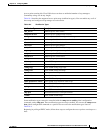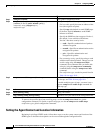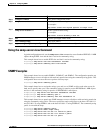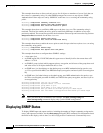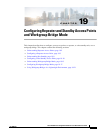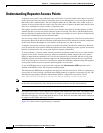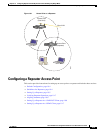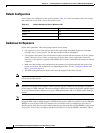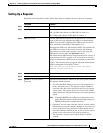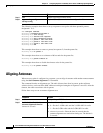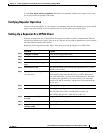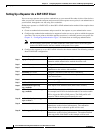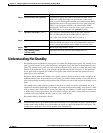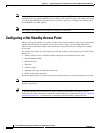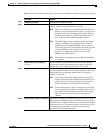
19-4
Cisco IOS Software Configuration Guide for Cisco Aironet Access Points
OL-30644-01
Chapter 19 Configuring Repeater and Standby Access Points and Workgroup Bridge Mode
Configuring a Repeater Access Point
Default Configuration
Access points are configured as root units by default. Table 19-1 shows the default values for settings
that control the access point’s role in the wireless LAN.
Guidelines for Repeaters
Follow these guidelines when configuring repeater access points:
• Use repeaters to serve client devices that do not require high throughput. Repeaters extend the
coverage area of your wireless LAN, but they drastically reduce throughput.
• Use repeaters when most if not all client devices that associate with the repeaters are Cisco Aironet
clients. When non-Cisco clients are expected, verify that these clients support the Aironet IE
extension, as this option is required on the SSID to allow for the communication between an AP and
a repeater.
• Make sure that the data rates configured on the repeater access point match the data rates on the
parent access point. For instructions on configuring data rates, see the “Configuring Radio Data
Rates” section on page 6-9.
• The SSID configured on the repeater radio must be mapped to the native VLAN.
Note Repeater access points running Cisco IOS software cannot associate to parent access points that that do
not run Cisco IOS software.
Note Repeater access points do not support wireless domain services (WDS). Do not configure a repeater
access point as a WDS candidate, and do not configure a WDS access point to fall back to repeater mode
in case of Ethernet failure. Repeaters can join a WDS infrastructure and act as WDS clients whenever
needed.
Note If multiple BSSIDs are configured on a root access point that is designated as the parent of a repeater,
the parent MAC address might change if a BSSID on the parent is added or deleted. If you use multiple
BSSIDs on your wireless LAN and a repeater on your wireless LAN is configured to associate to a
specific parent, check the association status of the repeater when you add or delete BSSIDs on the parent
access point. If necessary, reconfigure the disassociated device to use the BSSID’s new MAC address.
Table 19-1 Default Settings for Role in Wireless LAN
Feature Default Setting
Station role Root
Parent none
Extensions Aironet




